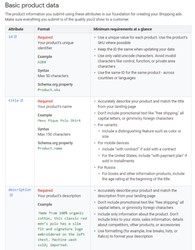If you sell products online, somewhere along the line you can be certain that product feeds are going to be involved.
There is a choice for those digital marketers and PPC managers dealing with product feeds for different ecommerce channels like Google Shopping or Facebook:
- Either manage product feeds manually
- Use product feed automation
Let’s take a look at why more and more are choosing the latter option.
The Benefits of Product Feed Automation
Feed automation tools are not only about the minimisation of manual tasks for ecommerce retailers and marketing agencies.
They’re also about optimising and enriching those product feeds to ensure your ads are given the best chances of being displayed at the time the searcher is most ready to buy. Any investment in feed optimisation (and automation) should, therefore, result in a tangible increase to your bottom line, delivering more impressions, greater ROAS and, ultimately, more sales.
Meeting the Channel Requirements
Seeing as it’s consistently the number one PPC network worldwide, let’s take Google Ads as our example.
Feed optimisation will always start with a study of the existing product feed. Before any extra factors can be added, the first step is always to ensure it meets the platform’s specifications.
Every channel like Google, Facebook, Bing, Bidvertiser or LinkedIn (plus hundreds more) has its own feed specifications. As the screenshot for a basic product feed for Google shows, these specifications include factors like different field names (such as ID or SKU), product titles, descriptions, prices, images, etc.
At its most basic level, a product feed tool automates the creation of your feed to have 100% certainty that it is the right feed for each channel. Instead of manual creation of the feed, a pre-built template ensures that the online store’s feed is matched to the Google requirements automatically.
If you do happen to submit an incomplete feed, you not only run the risk of products performing poorly on PPC channels and losing revenue, but are more likely to get the entire feed denied. That’s right, ….denied!
Optimizing the Product Feed
What comes next is incorporating additional features to the feed, all with the aim of boosting each products’ chances of being displayed at the right time, to the right person.
For PPC managers, your campaign results improve greatly if you are working with a well-structured, correctly formatted and informative product feed from the outset.
Some common feed optimizations involve factors like cleaning data (e.g. getting rid of HTML text which is included in product descriptions), merging new data to a feed (e.g. adding unique MPNs for each product) and making additions to your current product listings.
For Google, this will involve checking that your product titles and descriptions don’t contain duplicate words or banned characters (e.g. *!”#¤%), as well as adding extra fields to the title, such as: brand, size, colour or other relevant keywords can significantly improve campaign performance.
The example below shows a product feed description for a book with unwanted, leftover HTML.
This HTML is vital for your online store listings to know when to add paragraphs and breaks in the text, but you really don’t want that appearing on a Google Product Listing Ad or Facebook Dynamic Ad.
The process of going through all your product listings to copy, remove and correct each would be incredibly time-consuming. That’s why feed automation tools let you add ‘Expressions’ to your feed, which instantly applies to all the thousands of products in your feed.
The example below shows the same product description, which has had all the unwanted HTML removed in seconds only by using the expression htmlclean(field1).
When it comes to feed optimization, the more information you can provide, the more likely you are to convince your audience to make that crucial purchase decision.
Even if PPC managers are doing the hard work and effectively showing ads to the right audience at the right moments, if your ad only contains a basic title, image, and the stock description for that product, it will be time and effort wasted.
In this scenario, your audience might be left asking questions like:
- What size is the product?
- Is it for men or women?
- Does it come in different colours?
Adding all this extra info into a product feed, whether done manually or automated, makes you stand out above competitors and is worth it in the long run.
But on the other hand, take care not to go over the top! It might impress some channel algorithms when you have loads of extra info in your titles and descriptions – but remember that people have to read, understand, and take value from your product listings too.
Take a look at this example (below). No matter which channel you were using, if you were a shopper, it’s unlikely that this listing would attract your interest and lead to a purchase!
To Automate or Not to Automate?
Certainly, all of these factors to improve feed performance can be done in-house by a feed management expert, but without the automation of the process (such as adding the company’s unique branding to thousands of product images in seconds), it’s an incredibly time-consuming and laborious process.
For PPC managers, it’s vital that the products you’re working with contain the most up-to-date information with the newest stock values, availability and pricing. Feed automation also offers the benefit of running regular re-imports of the product feed, without any input needed from the feed managers.
When it gets to busy ecommerce periods like Black Friday, when these factors are rapidly changing, automation of the feed exports to Google, Facebook, Bing etc can be a godsend, ensuring that the correct info is always being displayed to the right audiences.
Optimizing the Performance of the Whole Campaign
If you are aware which individual products are performing well and which are just burning up your budget, you can take immediate action and remove unprofitable products.
Product feed automation tools not only help save hours in the initial stages of an ecommerce campaign, they continue playing a key role in the ongoing monitoring and evaluation stages.
Tracking the performance of specific products in campaigns and monitoring them in comparison to your closest competitors can all be done through the same automation tools which set up your feed. Not only does this give you an overview of how they are doing on a granular level – it gives you a head-start in pushing certain products at the opportune moment.
Saving Time Through Automation
Alongside the myriad factors that come with running successful PPC campaigns, the formatting, structuring and improvement of product feeds may take a backseat.
As you’ve seen, the manual process of changing individual product listings is long-winded and time-consuming, often leading many to neglect the process or pass the task to costly 3rd party developers. Fortunately, you can automate the entire setup and ongoing management of the feed – meaning you can get on with running your ads and be safe in the knowledge that all campaigns are up-to-date.
Product feed management tools like WakeupData will automate the entire process, ensuring that your ads are tailored to the channel requirements and enriched with industry-specific data to be as engaging as possible.
Ben is a content marketer for WakeupData, a company driven by its mission to help empower e-commerce businesses. He specializes in creating valuable, actionable content, which will save online merchants time and money.







